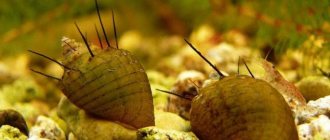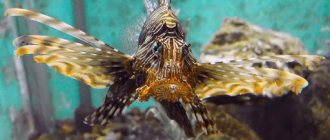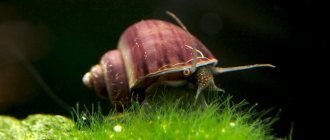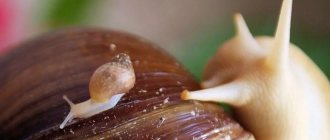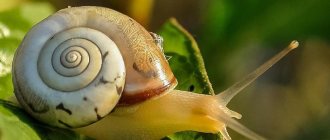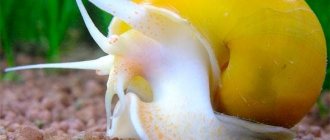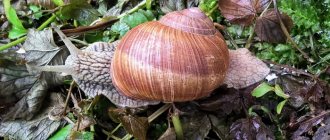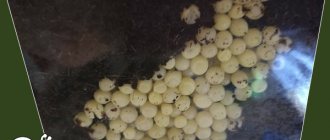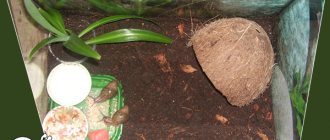The snail is an unusual creature that lives both in the wild and at home. Many people think that this is an insect, another part of humanity considers the snail to be an animal, but in fact, those who call this creature a mollusk are closer to the truth, since this animal is classified as a gastropod, a type of mollusk.
A unique feature of the snail is the presence of a hollow shell, which serves as a home for this animal. An excellent option is to have such a mollusk as a pet - no worries or hassle, and this creature will undoubtedly bring joy to its owners.
Description of the snail
The body of the snail, along with other representatives of the class Gastropods, is externally divided into parts such as the shell and the body, consisting of a leg and a head. The internal organs of the snail are surrounded by a special protective mantle, some of which is quite clearly visible even from the outside.
Appearance
The shell of an adult has an average diameter of 3.0-4.5 cm, and its volume is quite sufficient to fully accommodate the body . The shell is distinguished by a spiral curve of 4.5 turns. Shell coloration can vary from light tan to attractive brownish-white shades.
Along the entire length of the first two or three whorls there are five dark and the same number of light stripes. The saturation of color directly depends on the soil and climatic conditions in the habitat, the characteristics of the diet and the intensity of lighting.
This is interesting! The snail shell is distinguished by clearly visible ribbing, which increases the total surface area and significantly increases strength.
As a rule, the total length of the leg of a fully adult individual does not exceed 3.5-5.0 cm, but such a mollusk can easily stretch up to 8-9 cm. The body of the snail is characterized by increased elasticity, and the color can vary from beige with a brownish tint to dark gray color.
The surface of the body is covered with numerous wrinkles, the areas between which have the appearance of quadrangles. This feature allows the mollusk to retain moisture very effectively.
- Rodents
- 35 facts about foxes
- Animals of Brazil
- Tarantula spider
- 34 facts about lions
- Lynx
A pair of tentacles is located above the mouth opening, and their length may vary. The size of the labial or olfactory tentacles is 2.5-4.5 mm, and the eye ones do not exceed 10-20 mm. Vision allows the snail to clearly distinguish the intensity of light, as well as see objects located at a distance of no more than 10 mm.
Along with other numerous representatives of the Gastropod class, the grape snail has a digestive system represented by an ectodermal foregut and an endodermal midgut. The type of respiration of the above-ground mollusk is pulmonary. The heart is located above the hindgut, and includes the left atrium, ventricle and pericardium. Snail blood has no color. The reproductive system of the grape snail is hermaphroditic, therefore, to produce offspring, the mollusk undergoes cross-fertilization.
Key Security Points
There are several important safety considerations to keep in mind when preparing and eating snails:
- If you find a snail in the wild, you can wait about three or four days before eating it. There is a possibility that the snail has consumed several dangerous pesticides and other compounds outside your home. After a few days, all traces of what the snail has eaten should be removed naturally. The snail's intestines should have eliminated the toxins from the body after a few days without them...
- You should cook any snail you find completely to kill any potentially dangerous bacteria it may contain.
- Avoid consuming snails with their shells. In addition to being a choking hazard, some deposits can be difficult to clean. This especially applies to those who have many pores and cracks...
- While you can add salt or other spices over your snails after you've finished cooking them, you should avoid doing so before cooking them. Anything you add to snails before cooking can weaken them and break their bodies.
Types of snails
The most poisonous snail. The geographic cone snail (Conus geographus) is a native of the tropical and subtropical Indo-Pacific regions, found along the northern coasts of Australia. Their surrounding habitat includes live or fragmented coral reefs and sandy areas in tidal zones. They are less common in deeper waters.
The smallest snail
The geographic cone snail can kill 15 people with one bite. Symptoms include excruciating pain in the penetrating area, much worse than a bee sting. As the pain subsides, numbness soon sets in, followed by dizziness, slurred speech, and respiratory paralysis. Death may follow within half an hour after this, but such cases are rare. There is currently no known anti-venom; applied pressure to the wound, immobilization and artificial respiration (mouth-to-mouth resuscitation) are the only recommended treatment for the victim.
The smallest snail. The snail Angustopila dominikae is easy to miss, but several tiny shells were found among soil samples found beneath limestone rocks in China. They contained no snails, but the size of the shells indicates that the animals were less than 1 mm long, with the smallest specimen being only 0.86 mm long.
The biggest snail. Australia is home to the world's largest snail, the Australian whelk (Syrinx aruanus). The record representative is a snail with a long shell of 91 cm and a weight of 18 kg. On average, the Australian whelk grows up to 70 cm long. They are predatory snails and feed on large live polychaete worms. Due to their popularity, large specimens are now rare, although juveniles often wash ashore after storms and cyclones in northern Australia.
The biggest snail
According to their habitat, all snails are divided into land, freshwater and marine, and according to the type of respiration - into pulmonary and gill snails.
Pulmonary snails. About 35,000 species are known, which are usually classified as pulmonate snails. The species characteristic is a functional lung, which was formed from the mantle cavity. To take air into the respiratory organs, they have a breathing hole located at the edge of the snail shell or in the front part of the muscular body. Typical representatives of this group are grape snails (Helix pomatia), coil snails (Planorbidae), Achatina (Achatina) and various slugs.
Gill snails. In species that live in the salty waters of seas and oceans, as well as in freshwater bodies of water, gills are located in the mantle cavity. In addition to the organs that supply the snail’s body with oxygen, the mantle contains the exit ducts of the kidneys, which also includes the reproductive apparatus and excretory system. Among the known species of gill snails are Bithynia, lawn snails (Viviparidae), whelks (Buccinum) and many others. etc.
Littorina Littorea
Also known as the common periwinkle , Littorina littorea is a mollusk that can be found in abundance in the Atlantic Ocean, especially around the areas surrounding North America and Western Europe. Winkle snails are characterized by a smooth, dark, spiral shell. These sea snails usually live on rocks or under boats.
Lifestyle and habitat
The spread of gastropods occurred throughout almost all of Europe. Valleys, lawns, edges, overgrown ravines, city parks, gardens are a comfortable habitat for these unpretentious creatures.
The active state of snails lasts from the first sunny days of spring until the autumn cold. Seasonal wakefulness of mollusks does not exceed 5 months. Moisture-loving animals are often found among stones, in the shade of bushes, and burrow into damp moss.
During the day, during dry times, they are motionless, hiding in places where moisture is better preserved. They sit in shells covered with a thin film to prevent evaporation. As if glued to trunks or branches, they wait out the midday heat. Heat, like cold, numbs snails.
Night time and damp weather awaken snails to search for food. The mollusk gets out of its hiding place and hits the road. The muscular leg carries the cochlea due to muscle contraction and secreted mucus, which softens friction.
The surface on which the mollusk crawls can be horizontal, vertical, or located at any angle. The snail pushes off from the support and glides at a speed of up to 7 cm per minute.
There are many natural enemies of the snail. It is a delicacy for all reptiles, hedgehogs, and moles. Some beetles crawl inside the mollusk through the breathing hole. With the arrival of autumn cold, the snail buries itself in the ground with its mouth raised for hibernation.
This arrangement protects against bacteria, retains a small layer of air, and allows you to quickly get out of the shelter in high water. The period of suspended animation lasts approximately 3 months. The animal digs a hole with its muscular leg. Depending on the density of the soil, the dug channel reaches 6 - 30 cm. If the rocky soil does not give way, the snail finds refuge under the autumn leaves.
The mollusk covers the mouth of the shell with a special mucous veil. After hardening, the lime layer becomes a reliable lid. The thickness of the cork varies, depending on the severity of the winter. Air enters through a small hole. You can notice gas exchange by bubbles when the mollusk is immersed in water. Gastropods spend the wintering period alone, but sometimes gather in entire colonies. During wintering, the grape snail loses up to 10% of its weight.
In the spring, after awakening, the recovery period begins. Animal lovers are engaged in keeping and breeding shellfish. Although there are bans on their import into certain countries, interest in snails does not fade.
Haliotis Geigeri
Most often referred to as abalone , these marine molluscs belong to the Haliotidae family and are highly prized in the culinary world. Abalones can be found in the waters surrounding Yugãili Tomé and Príncipe, off the coast of Gabon, Africa. This sea snail is characterized by its oval, spiral shell and sticks to rocks where it feeds on plankton and algae.
What does a snail eat?
Everything a snail eats depends on its habitat. The nutrition of the mollusk is surprising in its diversity, it can be:
- the soft part of fresh plants.
- plant remains;
- small relatives;
- worms;
- carrion;
- fish;
- insects;
- crustaceans.
Land mollusks happily eat leaves, berries, fruits, vegetables, bark, and grass. Young ones prefer fresher food, but with age their preferences change, and the old snail begins to feed on rotten plants.
Some species eat flies, midges, mosquitoes, and carrion. A rotten tree can be a delicacy for a street snail.
In order to grind food well, the mollusk's teeth require calcium. Its deficiency leads to the fact that the snail begins to sharpen its shell, which collapses, leaving the body without protection. This leads to dehydration and death.
You can feed snails in an aquarium:
- fish food;
- aquarium plants;
- algae tablets;
- chopped vegetables.
To ensure that the aquarium is not left without all vegetation, it is best to take control of the number of mollusks. A moderate amount of snails is good for the algae as it eats up all the rot on it and cleans the aquarium. It is also recommended to grind eggshells in a coffee grinder to replenish calcium in the body of gastropods.
It is worth monitoring your pet’s diet; he should not be given human food. You also need to put newspapers away, because the snail eats them with great pleasure, but rarely survives after such a feast.
You can include the diet:
- plantain;
- legumes;
- cucumbers, zucchini, pumpkin, tomatoes, bell peppers;
- greenery;
- dandelions;
- bananas, watermelon, pears, strawberries, apples.
For land representatives, do not forget to put a bowl of clean water.
Aspers spiral
More commonly known as the garden snail , Helix aspersa, it can be found throughout the world, including North and South America, Oceania, Europe, South Africa and parts of the British Isles. This herbivorous snail is usually found between gardens and crops. Because the garden snail often attacks and feeds on crops, it is considered a nuisance to humans and therefore pesticides kill it.
Snail reproduction and lifespan
Snails are considered hermaphrodites. Therefore, two mature individuals are sufficient for reproduction. The mating period takes place in spring or early autumn.
Eggs are laid in a prepared hole or in some natural shelter, for example, near the root weaves of plants. The clutch consists of 30-40 white shiny eggs up to 7 mm in size. The incubation period is 3-4 weeks.
Newborn snails emerging from eggs have a transparent shell with a curl of one and a half turns. Snails have been living independently since birth.
The young animals eat the remains of the eggshell, feed on the soil and the substances contained in it until they get out of the shelter. Formation occurs within 7-10 days in the nest, and then on the surface in search of plant food. Over the course of a month, snails increase in size by about 3-4 times.
Only by 1.5 years does the snail reach puberty, but only 5% of those born reach this period. About a third of the mollusks die after the breeding season.
The average life expectancy in natural conditions is 7-8 years, if it does not fall into the hands of a predator. Under favorable artificial breeding conditions, the domestic grape snail lives up to 20 years. There is a known case of a record keeping of a grape snail at 30 years old.
Despite the wide territorial distribution of shellfish, they have always been objects of human consumption due to the nutritional value of meat as a food product and medical significance in the treatment of eye diseases, musculoskeletal diseases, stomach problems and for cosmetic purposes.
The mucus of gastropods improves the restoration processes of the skin after damage. Snails enhance collagen production and blood microcirculation, which help improve skin structure and rejuvenate it.
The preparation of grape snails is traditional in the Mediterranean countries and many European countries. Rich in protein and minerals, shellfish dishes are valued by gourmets. The best recipes for grape snails are known to residents of France, Spain, Italy, and Greece.
The snail is simple and mysterious at the same time. Coming from ancient times, it has changed little and still attracts human interest in its natural life.
Potamopyrgus antipodar
Known as the New Zealand mud snail , this species of freshwater snail is endemic to New Zealand, but can also be found in Australia, Europe and North America. This snail has a long shell with a clearly defined shelf life that can range from white to gray. The New Zealand mud snail feeds on plant debris, algae and diatoms.
Snail shells
The shells of gastropods are diverse and in many respects the shape depends on the lifestyle of the mollusk, the color of the shell depends on the arrangement of protein molecules, and its thickness on the amount of minerals spent on construction. Clam shells are natural works of art, often consisting of several layers. Land species of mollusks often have a two-layer shell; the layers themselves have different characteristics and growth patterns. For example, the middle layer, or rather the inner one, can grow only in length, gradually increasing the number of turns on the shell, while the outer layer can increase both in length and width, gradually thickening the walls of even the newest turns.
- The inner layer of the gastropod shell is covered with a special film, which, despite its apparent fragility, can perfectly protect the animal from drought - the main enemy of the snail. This film is found only in land species; it reliably hides the snail from the outside world and seals the contents of the shell, causing the snail to hibernate. Scientists have found that a gastropod in this state can survive significant temperature fluctuations and even for a long time in the ice cover.
- Some types of mollusks have a muscle in their structure that can pull their body into the shell. In fact, contrary to popular belief, the shell does not protect gastropods from enemies, it is little effective against birds and other large hunters, and in some cases it can only protect against small predators, such as crabs and insects.
- The thickness of the shell is very dependent on the lifestyle of a certain type of snail; for example, representatives of the class of gastropods living in moss have a much whiter, more fragile shell than those living on open surfaces.
- The determining factor is the speed of movement; the faster the snail, the more elongated its shell will be. This is a kind of aerodynamic quality of the shell that helps the snail move. The shell can tell you whether a clam is left-handed or right-handed, it's really that simple. Whichever direction the shell is twisted is the main one.
Most species known to science have a smooth, rough surface of the shell, which is very convenient for land species. Marine representatives , especially the inhabitants of the coral reef, have growths on their “home” that are necessary for camouflage. The coloring of the shell of most species is aimed at camouflage and increasing the chances of survival.
Representatives of the aquatic world often have darker colors, for example, gastropods living on a sandy bottom will have a color that is close to the general background, the same applies to those who live in algae. Among the many species of land and sea species, one can notice very striking representatives. But you don’t need to be happy to meet them; a bright color in nature often indicates that its carrier is poisonous. Sometimes completely harmless animals can use bright colors, but it is this coloring that will be “copied” from its poisonous counterpart.
As for the size of the gastropod, it can be tiny or a real giant.
- Representatives of land species often have a rather small size, which also depends on the humidity in the habitat.
- Large individuals can only be found in the ocean, most often they live on safe shallows or coral reefs, which allows them to feed and grow freely without fear of predators.
Initially, gastropods lived in the seas and oceans, gradually moving to land. Most species of gastropods still live only in the sea . Well, the largest range of their species can be found in countries with a tropical climate.
Insects and snails do not have any common relatives or similar external features; they are completely different and belong to different kingdoms of nature. Most insects have a chitinous shell on their body, protecting them from external problems, and mollusks have a soft body, often without any protection at all.
Cone Magus
Better known as the ' magic cone ', this sea snail is native to the Pacific and Indian oceans. Conus magus The species is characterized by a venomous bite that can be fatal. Magic cone sea snail venom contains approximately 50,000 different components known as conotoxic.
Did you know that Conus magus is a poison used in the pharmaceutical industry? Its poisonous components are isolated to produce painkillers that are used for cancer and HIV patients.
Useful properties of snail
Snails are prepared in a very unusual way. They are collected from vineyards, cleansed their body (starved), lightly washed in water and transferred to a container filled with coarse salt, where they are left for two hours so that they release mucus. After this, the snails are lightly boiled and then stewed for about an hour in grape wine with butter, onions, tomatoes and spices, as an option. During the cooking process, snail meat absorbs all the flavors of the spices. The high content of vitamin B6 makes their protein meat easy to digest.
Grape snail meat contains 70% protein and 30% amino acids.
Snail mucus contains a significant amount of biologically active substances. Among them are amino acids, vitamins, alantoin, elastin, collagen, natural antibiotics in natural form, used by the snail to restore its damaged body, as well as its limestone house.
In Spain, France and Italy, the grape snail is eaten, and its taste is believed to be superior to that of other edible snails. Large snails are usually served in their own shells, seasoned with butter, garlic, onion and parsley.
Small ones are most often used to make sauces or stews, or added to soups; this is already the culinary art of the French.
Snail meat contains a large amount of valuable protein, almost one and a half times higher than its content in a chicken egg. It is low in fat and very nutritious. It also contains a complex of essential amino acids, which gives it the right to be successfully used as a dietary product.
Since ancient times, snails have been credited with the ability to cure various diseases. It is not for nothing that snails were considered a symbol of eternity in Babylon and Egypt. For some time, snail mucus as a remedy was undeservedly forgotten. However, in recent years, scientists have paid a lot of attention to the study of snail mucus.
The property of snail mucus to glue bacterial cells has found application in the treatment of diseases of the respiratory system, such as bronchitis, whooping cough and silicosis. In the old days, folk healers would sit a snail on a piece of sugar and, after it became covered in mucus, give it to someone who was sick with whooping cough.
Using its own mucus, the snail can completely rebuild its shell. Thanks to such powerful restorative properties, snail mucus has found wide use in cosmetology. The mucus of common garden snails is included in many modern cosmetics, as it has strong antioxidant and antibacterial properties. In addition, snail mucus has the unique property of creating a protective film that does not allow moisture to pass through, but at the same time allows air to pass through perfectly.
Snail mucus also has a powerful regenerating effect. This was first noticed in shellfish factories. The workers who bred them had skin on their hands that resembled that of a child. Moreover, abrasions and scratches on the hands of breeders healed much faster than those of those who did not come into contact with mollusks. The regenerating properties of snail mucus are due to the content of allantoin, glycolic acid, collagen and elastin. Balms and creams based on snail mucus effectively fight stretch marks, scars and acne.
Garden snail mucus does not cause an allergic reaction. It is effective in treating warts, burns, and age spots.
golden elephant
The homeland of this amazing snail is the Indonesian island of Sulawesi. Shellfish are common in Lake Poso and the Malili River. Individuals were brought to Europe by the Dutch in the 19th century. Since then, tilomelania have adapted to various conditions and began to be kept in the aquarium.
i1.wp.com
Tilomelania or rabbit snail is large in size. Its shell is conical, tapered, and reaches 12 cm in length. The shell may be smooth or have needle-like spines in the shape of curls. The body of snails is multi-colored:
- yellow;
- cream;
- orange;
- black with yellow or white spots.
The most common name is golden elephant, given to the individual due to its interesting structure. All specimens have a huge elongated trunk, incomparable to the size of the mollusk itself. It not only adds beauty to the snail, but is used by it to filter squeaks and search for prey.
You can keep a golden elephant in a spacious home aquarium. The main thing is to maintain optimal conditions, otherwise the individual will die.
Care and maintenance of snails at home
Exotic pets will not require significant time and financial investment. Caring for snails is simple and not troublesome: you only need to feed them 3 times a week, wash the aquarium once every 2 weeks and change the soil once a month. They are unpretentious in their diet: they eat vegetables, fruits, and grass. You don't have to think about what to feed them: food from the refrigerator will do just fine. If you have a crispy lettuce leaf for dessert, it’s a real delicacy for the snail!
Gastropods usually live in aquariums equipped with a lid with holes or a gap: so that the pet does not suffocate and crawl out along the wall. Begonia soil or coconut substrate is suitable as bedding. You can line the ulitharium with moss, add branches with lichen, plant plants, for example, cat grass, or arrange a pond from a saucer. If you went to the nearest planting or to the forest to get moss, then before placing it in the aquarium, you need to treat it in a special way.
A couple of times a day, it is advisable to spray the soil and walls of the urinal with a spray bottle. If you notice that your pet sits on the wall all the time, there is too much water and he is uncomfortable in the wet ground. If it is clogged in the sink, then, on the contrary, it is too dry.
You need to understand that the activity of the inhabitants of the ulitaria depends on proper care. Basically, earth snails are nocturnal, and during daylight hours they prefer to sit motionless on glass or burrow into the ground.
It happens that snails hibernate, but not necessarily in winter. The cause may be low humidity in the urinary tract, low temperature, lack of nutrients in the diet, stress and injury. Then the mollusk hides and seals the entrance to the shell with a special sticky substance, which forms a film - epiphagma. You can wake up your pet by pouring warm boiled water on the sink or placing it in an aquarium with an acceptable temperature and humidity and spraying it with water from a spray bottle. After a while, he will understand that the environment is favorable and will look out of the shell.
Reproduction and care of eggs is also not difficult for beginning snail breeders. The main thing is to maintain the temperature in the aquarium at about 28 degrees and not disturb the masonry. It is better to feed the snails solid food, in which they cannot bury themselves and suffocate. It is best to cover them with lettuce leaves instead of soil, and give them grated greens and carrots. But you shouldn’t accustom them to cucumbers: snails are not indifferent to them, and may subsequently refuse to eat anything else. Otherwise, the snails require virtually no care, and the main problem will be the need to place the babies in good hands.
Buccinum undatum
Owl (Buccinum undatum) The mollusk can be found in the surrounding waters of the Atlantic Ocean, where it prefers to live in areas with temperatures around 29 degrees. The snail type does not tolerate exposure to air. If you come out of the water and are exposed to air, your body will dry out.
Interesting facts about snails
- The ancient Greeks used snails as a medicine.
- The Phoenicians extracted red and red-violet dye – purple – from the shells of certain types of snails.
- Contrary to popular belief, the most toothy animal is not a shark, but a grape snail. Her mouth contains more than 25,000 small and sharp teeth.
- The structure of the snail's brain allows it to remember the location of food in space and return to it even after one hour.
- The Burgundy snail is capable of making sounds similar to a quiet creaking.
Video
Mollusks in world culture
In the modern world, the role of snails is usually limited to culinary purposes. But it was not always so. In the past, some peoples considered gastropods to be “unclean” animals that were of no use. The same cannot be said about the ancient Greeks, who used snails to determine the time of harvest: they saw “houses” on the stems - which means the gods allowed them to reap the fruits. For the ancient Babylonians and Egyptians, snails were a symbol of eternity, and the Aztecs generally idolized this mollusk - they considered it the god of the moon. The first information about the consumption of these gastropods for food also dates us back to antiquity. It is known that the ancient Romans did not disdain snails, and this protein-rich meat appeared equally often on the plates of the nobility and the poor.
